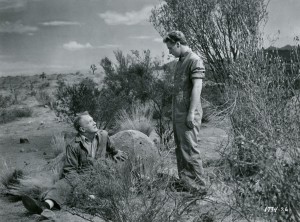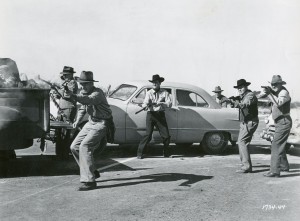by Barb Lentz.
The five movies Bob provided me from which to choose were these:
Day for Night (1973)
G Men (1935)
It Came from Outer Space (1953)
The Pawnbroker (1965)
Sahara (1943)
I chose It Came from Outer Space because it is science fiction and we haven’t done one of these yet, at least not from the 1950s. I had no idea that this movie was made by the same person who made The Incredible Shrinking Man, which I feel is very good, and I didn’t recall that Bob had actually met and interviewed that person, director Jack Arnold. But Bob was happy to remind me of those facts.
With that title and the scary artwork on the DVD (although the alien there has two eyes instead of just one as in the movie — as well as some guy I don’t recognize from the film!), I was expecting a rather standard people vs. alien battle story where the humans prevail. But that isn’t what this movie is all about. It has the framework for an alien invasion, but then the aliens don’t invade. We’re not sure just what they are doing when they take over the bodies of the telephone line workers. How can they look directly at the sun without going blind? Just why do they go to the main character’s home and take his clothes? Are they communicating, or even moving, through the telephone lines? This film is more of a mystery than a monster movie.

That’s probably why I enjoyed it as much as I did. This movie uses a unique approach and isn’t dumb like so many monster movies. It makes you wonder just why the aliens are there, and what the people are going to do about them. When astronomer John Putnam (Richard Carlson) corners the aliens who have taken over Frank (Joe Sawyer) and George (Russell Johnson) in an alley, Frank tells Putnam that they need time, and that creates genuine suspense. Time for what? Putnam doesn’t know, and neither do we.
The movie jumps into action right away, almost opening with the meteor crash and gives us a glimpse of the ugly one-eyed alien with the weird hair before any of the characters see it. The spaceship itself is very interesting, a sphere made up of hexagonal panels; I don’t ever recall seeing another one like it in the movies. It’s another original touch in this movie which evidently started the trend of using the desert as an eerie setting for encounters with aliens, giant ants and the like. It sure works well, especially in the night scenes when the misshapen Joshua trees look like marauding monsters!
Ultimately the story boils down to either taking action, or not taking action. Putnam reluctantly agrees to wait as the aliens ask, while the sheriff (Charles Drake) cannot. Sometimes the best action is not to take action. The sheriff puts everyone at risk when he finally cannot help himself, and it is only because Putnam interferes with the sheriff’s plans that the Earth is not destroyed. Putnam is the voice of reason, trusting the aliens as far as he can even after they try to kill him, but also negotiating with them to release their human hostages. He is a worthy hero.
My top five moments of the movie are:
1. When we see the spherical spacecraft through the mist in the crater for the first time, and then again when Putnam approaches it for the first time. That first glimpse reveals that this is certainly no meteor . . . and then the hexagonal door opens. This is what science fiction is all about.

2. When Frank invites Putnam to listen to the strange noise in the telephone lines. It’s a moment that doesn’t make a lot of sense to me (are the aliens somehow in the wires?) but it conveys exactly the right alienness of the situation and of the desert that surrounds them.
3. The doorway scene when John Putnam corners aliens Frank and George in the alley. Putnam still isn’t sure that they aren’t Frank and George until they tell him to stay away. Then he pulls a gun and has to decide what to do. He uses his reason and lets them leave. It’s probably the most courageous thing he could have done, even though he second guesses his choice constantly after that. He innately trusts the aliens, perhaps because Frank tells him, “We don’t want to hurt you, you least of all. We don’t want to hurt anyone.” The “you least of all” intimates that the aliens know who he is, and that he is worthy of trust, in spite of the fact that he is pointing a gun at Frank at the time. Putnam puts away the gun and lets them go.
4. When Putnam confronts the aliens in the mine, and finds that the alien leader is his own double. How is that possible? Every other “abduction” was done in person, with the aliens taking the human hostage, even Ellen (Barbara Rush). How did they get Putnam’s likeness, when he is still walking around freely? It doesn’t matter, but it adds to the alien mystery. And it adds to the movie’s effectiveness to have the lead character suddenly facing himself with the fate of the world at stake.
5. When the aliens get away. What a relief! When all is said and done, they were only here to fix their spacecraft; they just needed a little help to do it. The aliens don’t kill anyone (although one tries to kill Putnam), they don’t steal anyone’s soul and they bring a great deal of excitement to this sleepy little desert hamlet. Then they leave and everyone can go back to their own lives, which will never, ever be the same again now that they know they are not alone in the universe.
Is It Came from Outer Space a classic? Yes. It’s one of the best science fiction films I’ve ever seen because it isn’t really about aliens at all — it’s about how we would react to them if they arrived. Putnam tries to keep an open mind, wanting to help them, yet even he turns away from an alien who reveals itself to him in its real form. Its unique approach, poetic dialogue, strong characters, subtle subversiveness and realistic dilemmas all contribute to making this a memorable movie experience.
BRL 19 November 2014.
It Came from Outer Space (May 25, 1953) Universal.
Directed by Jack Arnold. Produced by William Alland.
Screenplay by Harry Essex. Based upon a story by Ray Bradbury.
Principal Cast (character, performer):
John Putnam Richard Carlson
Ellen Fields Barbara Rush
Sheriff Matt Warren Charles Drake
Frank Daylon Joe Sawyer
George Russell Johnson
June Kathleen Hughes
Pete Davis Dave Willock
Mrs. Daylon Virginia Mullen
Dr. Snell George Eldredge
81 minutes. Black and White. Originally 3-D. Not Rated.
